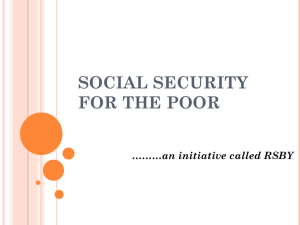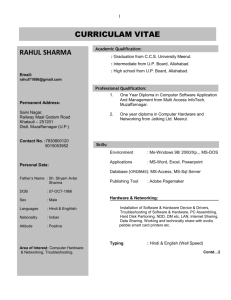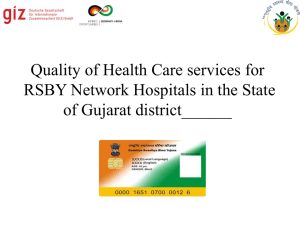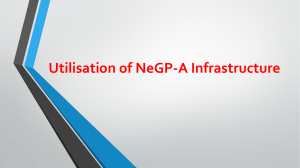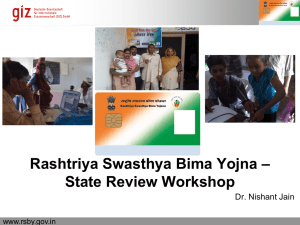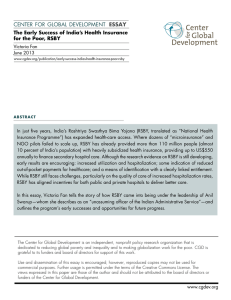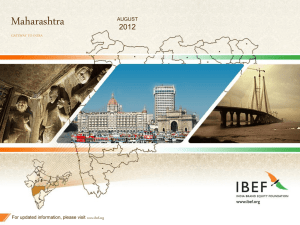Social Exclusion and Rashtriya Swasthya Bima Yojana
advertisement
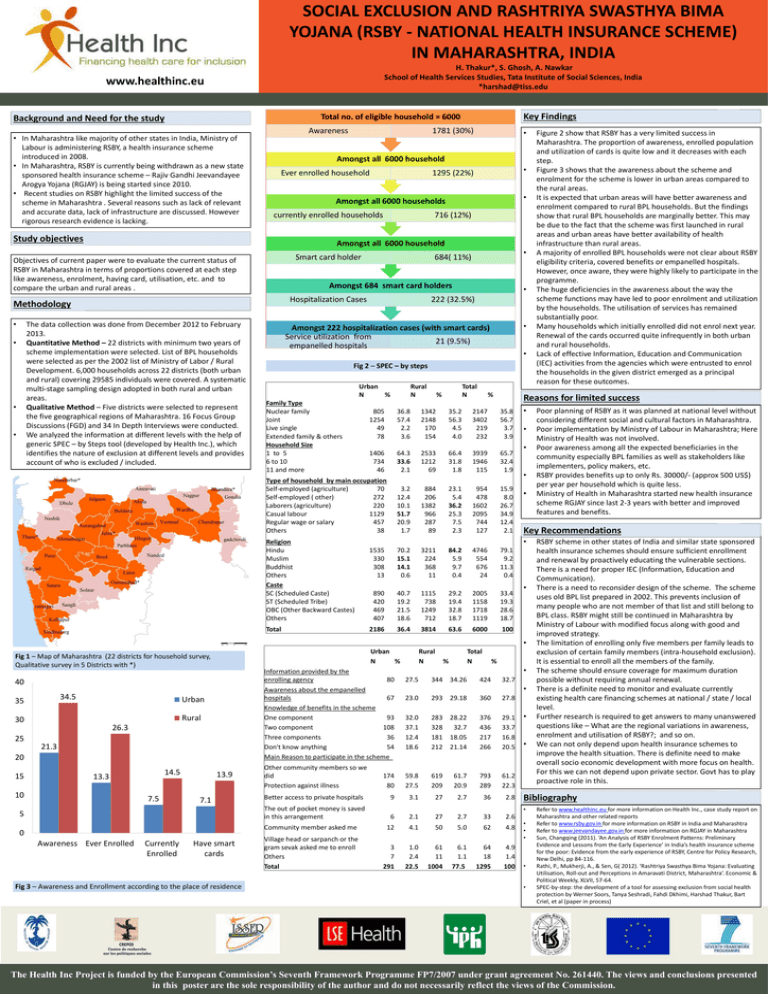
SOCIAL EXCLUSION AND RASHTRIYA SWASTHYA BIMA YOJANA (RSBY - NATIONAL HEALTH INSURANCE SCHEME) IN MAHARASHTRA, INDIA H. Thakur*, S. Ghosh, A. Nawkar School of Health Services Studies, Tata Institute of Social Sciences, India *harshad@tiss.edu www.healthinc.eu • In Maharashtra like majority of other states in India, Ministry of Labour is administering RSBY, a health insurance scheme introduced in 2008. • In Maharashtra, RSBY is currently being withdrawn as a new state sponsored health insurance scheme – Rajiv Gandhi Jeevandayee Arogya Yojana (RGJAY) is being started since 2010. • Recent studies on RSBY highlight the limited success of the scheme in Maharashtra . Several reasons such as lack of relevant and accurate data, lack of infrastructure are discussed. However rigorous research evidence is lacking. Awareness Ever enrolled household • 716 (12%) Amongst all 6000 household Smart card holder • 684( 11%) Amongst 684 smart card holders Hospitalization Cases The data collection was done from December 2012 to February 2013. Quantitative Method – 22 districts with minimum two years of scheme implementation were selected. List of BPL households were selected as per the 2002 list of Ministry of Labor / Rural Development. 6,000 households across 22 districts (both urban and rural) covering 29585 individuals were covered. A systematic multi-stage sampling design adopted in both rural and urban areas. Qualitative Method – Five districts were selected to represent the five geographical regions of Maharashtra. 16 Focus Group Discussions (FGD) and 34 In Depth Interviews were conducted. We analyzed the information at different levels with the help of generic SPEC – by Steps tool (developed by Health Inc.), which identifies the nature of exclusion at different levels and provides account of who is excluded / included. • • 1295 (22%) currently enrolled households Methodology • • Amongst all 6000 households Objectives of current paper were to evaluate the current status of RSBY in Maharashtra in terms of proportions covered at each step like awareness, enrolment, having card, utilisation, etc. and to compare the urban and rural areas . • 1781 (30%) Amongst all 6000 household Study objectives • Key Findings Total no. of eligible household = 6000 Background and Need for the study • 222 (32.5%) • Amongst 222 hospitalization cases (with smart cards) Service utilization from 21 (9.5%) empanelled hospitals • Fig 2 – SPEC – by steps Urban N % Family Type Nuclear family Joint Live single Extended family & others Household Size 1 to 5 6 to 10 11 and more Rural N 805 1254 49 78 36.8 57.4 2.2 3.6 1406 734 46 Type of household by main occupation Self-employed (agriculture) 70 Self-employed ( other) 272 Laborers (agriculture) 220 Casual labour 1129 Regular wage or salary 457 Others 38 Religion Hindu Muslim Buddhist Others Caste SC (Scheduled Caste) ST (Scheduled Tribe) OBC (Other Backward Castes) Others Total Total N % 1342 2148 170 154 35.2 56.3 4.5 4.0 % 2147 3402 219 232 Reasons for limited success 35.8 56.7 3.7 3.9 64.3 33.6 2.1 2533 1212 69 66.4 31.8 1.8 3939 1946 115 65.7 32.4 1.9 3.2 12.4 10.1 51.7 20.9 1.7 884 206 1382 966 287 89 23.1 5.4 36.2 25.3 7.5 2.3 954 478 1602 2095 744 127 15.9 8.0 26.7 34.9 12.4 2.1 • • • • • 70.2 15.1 14.1 0.6 3211 224 368 11 84.2 5.9 9.7 0.4 4746 554 676 24 79.1 9.2 11.3 0.4 890 420 469 407 40.7 19.2 21.5 18.6 1115 738 1249 712 29.2 19.4 32.8 18.7 2005 1158 1718 1119 33.4 19.3 28.6 18.7 2186 36.4 3814 63.6 6000 100 • • Urban N % Fig 1 – Map of Maharashtra (22 districts for household survey, Qualitative survey in 5 Districts with *) Information provided by the enrolling agency 40 34.5 35 Rural 30 25 26.3 21.3 20 15 14.5 13.3 10 7.5 13.9 7.1 Other community members so we did Protection against illness Better access to private hospitals The out of pocket money is saved in this arrangement 5 0 Awareness Ever Enrolled Currently Enrolled Have smart cards Fig 3 – Awareness and Enrollment according to the place of residence Total N % % • 80 Awareness about the empanelled hospitals 67 Knowledge of benefits in the scheme One component 93 Two component 108 Three components 36 Don't know anything 54 Main Reason to participate in the scheme Urban Rural N 27.5 344 34.26 424 32.7 • 23.0 293 29.18 360 27.8 32.0 37.1 12.4 18.6 283 28.22 328 32.7 181 18.05 212 21.14 376 436 217 266 29.1 33.7 16.8 20.5 174 80 59.8 27.5 619 209 61.7 20.9 793 289 61.2 22.3 9 3.1 27 2.7 36 2.8 • • 2.1 27 2.7 33 2.6 Community member asked me 12 4.1 50 5.0 62 4.8 Village head or sarpanch or the gram sevak asked me to enroll Others Total 3 7 291 1.0 2.4 22.5 61 11 1004 6.1 1.1 77.5 64 18 1295 4.9 1.4 100 RSBY scheme in other states of India and similar state sponsored health insurance schemes should ensure sufficient enrollment and renewal by proactively educating the vulnerable sections. There is a need for proper IEC (Information, Education and Communication). There is a need to reconsider design of the scheme. The scheme uses old BPL list prepared in 2002. This prevents inclusion of many people who are not member of that list and still belong to BPL class. RSBY might still be continued in Maharashtra by Ministry of Labour with modified focus along with good and improved strategy. The limitation of enrolling only five members per family leads to exclusion of certain family members (intra-household exclusion). It is essential to enroll all the members of the family. The scheme should ensure coverage for maximum duration possible without requiring annual renewal. There is a definite need to monitor and evaluate currently existing health care financing schemes at national / state / local level. Further research is required to get answers to many unanswered questions like – What are the regional variations in awareness, enrolment and utilisation of RSBY?; and so on. We can not only depend upon health insurance schemes to improve the health situation. There is definite need to make overall socio economic development with more focus on health. For this we can not depend upon private sector. Govt has to play proactive role in this. Bibliography • 6 Poor planning of RSBY as it was planned at national level without considering different social and cultural factors in Maharashtra. Poor implementation by Ministry of Labour in Maharashtra; Here Ministry of Health was not involved. Poor awareness among all the expected beneficiaries in the community especially BPL families as well as stakeholders like implementers, policy makers, etc. RSBY provides benefits up to only Rs. 30000/- (approx 500 US$) per year per household which is quite less. Ministry of Health in Maharashtra started new health insurance scheme RGJAY since last 2-3 years with better and improved features and benefits. Key Recommendations • 1535 330 308 13 Figure 2 show that RSBY has a very limited success in Maharashtra. The proportion of awareness, enrolled population and utilization of cards is quite low and it decreases with each step. Figure 3 shows that the awareness about the scheme and enrolment for the scheme is lower in urban areas compared to the rural areas. It is expected that urban areas will have better awareness and enrolment compared to rural BPL households. But the findings show that rural BPL households are marginally better. This may be due to the fact that the scheme was first launched in rural areas and urban areas have better availability of health infrastructure than rural areas. A majority of enrolled BPL households were not clear about RSBY eligibility criteria, covered benefits or empanelled hospitals. However, once aware, they were highly likely to participate in the programme. The huge deficiencies in the awareness about the way the scheme functions may have led to poor enrolment and utilization by the households. The utilisation of services has remained substantially poor. Many households which initially enrolled did not enrol next year. Renewal of the cards occurred quite infrequently in both urban and rural households. Lack of effective Information, Education and Communication (IEC) activities from the agencies which were entrusted to enrol the households in the given district emerged as a principal reason for these outcomes. • • • • • Refer to www.healthinc.eu for more information on Health Inc., case study report on Maharashtra and other related reports Refer to www.rsby.gov.in for more information on RSBY in India and Maharashtra Refer to www.jeevandayee.gov.in for more information on RGJAY in Maharashtra Sun, Changqing (2011). ‘An Analysis of RSBY Enrolment Patterns: Preliminary Evidence and Lessons from the Early Experience’ in India’s health insurance scheme for the poor: Evidence from the early experience of RSBY, Centre for Policy Research, New Delhi, pp 84-116. Rathi, P., Mukherji, A., & Sen, G( 2012). ‘Rashtriya Swasthya Bima Yojana: Evaluating Utilisation, Roll-out and Perceptions in Amaravati District, Maharashtra’. Economic & Political Weekly, XLVII, 57-64. SPEC-by-step: the development of a tool for assessing exclusion from social health protection by Werner Soors, Tanya Seshradi, Fahdi Dkhimi, Harshad Thakur, Bart Criel, et al (paper in process) The Health Inc Project is funded by the European Commission’s Seventh Framework Programme FP7/2007 under grant agreement No. 261440. The views and conclusions presented in this poster are the sole responsibility of the author and do not necessarily reflect the views of the Commission.

